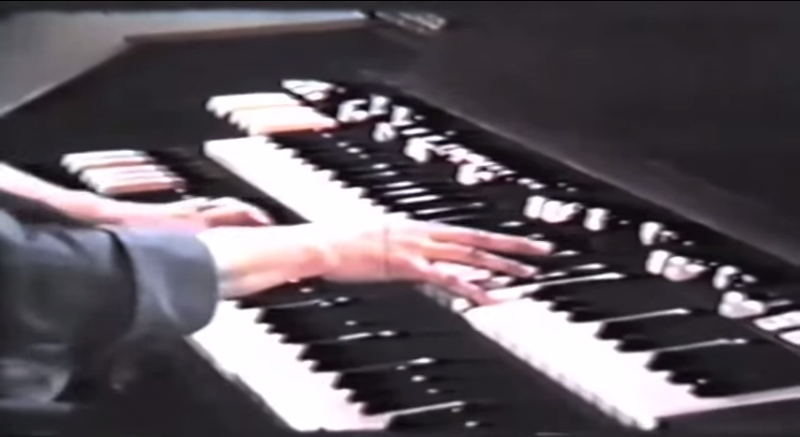Here’s a short film made by the Hammond Organ Company with the intent to educate and persuade potential consumers. Right away we are assured that Hammond organs are the cream of the crop for two simple reasons: the tone generator that gives them that unique Hammond sound, and the great care taken at every step of their construction.
Hammond organs have ninety-one individual electromagnetic tone wheel assemblies. Each of these generate a specific frequency based on the waviness of a spinning disk’s edge and the speed at which it is rotated in front of an electromagnet. By using the drawbars to stack up harmonics, an organist can build lush walls of sound.
No cost is spared in Hammond’s tireless pursuit of excellence. All transformers are wound in-house and then sealed in wax to make them impervious to moisture. Each tone wheel is cut to exacting tolerances, cross-checked, and verified by an audio specialist. The assembly and fine tuning of the tone generators is so carefully performed that Hammond alleges they’ll never need tuning again.
This level of attention isn’t limited to the guts of the instrument. No, the cabinetry department is just as meticulous. Only the highest-quality lumber is carefully dried, cut, sanded, and lacquered by hand, then rubbed to a high shine. Before it leaves the shop, every Hammond organ is subject to rigorous inspection and a performance test in a soundproofed room.
http://www.youtube.com/watch?v=6jKme27M6xU
Thanks for the tip, [LaLaLamer].
Retrotechtacular is a weekly column featuring hacks, technology, and kitsch from ages of yore. Help keep it fresh by sending in your ideas for future installments.















All I can think of now is the Red Dwarf theme played by a hammond organ…
came here just to say something like this.
Ahem gentlemen…
https://www.youtube.com/watch?v=BvBhr3yHpcQ
Ahem gentlemen….
https://www.youtube.com/watch?v=rp6HYw1tUio
Here is what a Hammond sounds like in the hands of a genius, https://www.youtube.com/watch?v=nO8Ln1WXsWU
And here in the hand of a lunatic, https://www.youtube.com/watch?v=TTrbIvKdKo0
Oddly I liked this better than the snoozefest above.
https://www.youtube.com/watch?v=SXBR96Z8_e8
Here’s my contribution. The Charlatans, 1992. “Wierdo”.
There is nothing like a slick Hammond x-mas medley:
https://www.youtube.com/watch?v=-JHNl1BWxro
If you say Emerson your next word must be Lord: https://www.youtube.com/watch?v=4mW9b_KRedQ
yup. cant argue with that
Quite a few psychedelic / indie bands, in the 1960s and late 1980s / 90s, used Hammonds for their groovy sound. I’ve got a few tunes I still listen to with Hammonds in them. The Charlatans and Inspiral Carpets being 2 bands. They’re great for modern music, not just replacing old pipe organs and jazzing up a game of bingo.
I have a 1964 Hammond I got at the Goodwill for $25 around 10 years ago, from what I can tell all original components and it still works just about perfectly although I do get an occasional crackle from the reverb amp which might mean a cap is finally going. This thing is over 50 years old and half of it isn’t even electronic but electromechanical – tone wheels, spring reverb, and a chorus which uses a capacitive disk delay connected to the tone wheel assembly! I grew up in Chicago a mile away from the Hammond factory, which incidentally was right down Western Ave. from the Bally and Williams pinball factories and I am here to say they don’t make stuff like this anymore! Unlike modern electronic keyboards you need to oil your tone wheel bearings around every 6 months, maybe you could use an Arduino to automate the oiling?
When I first learned about the tone wheel concept for producing waveforms, my reaction was a mixture of “That’s genius” and “That’s insane”.
I got a free Hammond Aurora from the mid-70’s. It was transistor based rather than tone wheels, it weighed a ton and it sounded kind of cheesy. I took it apart and made a Leslie rotary guitar combo with spring reverb and a bass amp with a 12″ and a 6″x9″. I used one of the keyboards with a voltage divider wired to each key. I connected it to an Arduino granular synth and tuned each voltage divider to make a chromatic scale. Super cool!
I’ve canibalized a lot of organs over the years and Hammonds are by far the most hacker friendly. Thanks for the vid.
My favorite organ conversion project remains the Chipophone from lft (Linus Akesson): http://www.linusakesson.net/chipophone/
Oh! to look at all that shiny metal. All the ones I see are well oxidized a dull grey. Then there is that Eastman color and the aspect ratio fubar.
Saw one out of a church that come the closest to that new look.
The Hammond B3 was THE organ for more than a few bands in the 60’s & 70’s. Connected to a Leslie speaker, the tones were just plain awesome. If you have ever heard the Allman Brothers play, you know the sound.
https://www.youtube.com/watch?v=7rQWh62VUHE
Ah, so we’re posting our favorite Hammond solos and such? Check out this guy absolutely KILLING it on a classic C3:
[youtube http://www.youtube.com/watch?v=3RS2LTKq9ss&w=420&h=315%5D